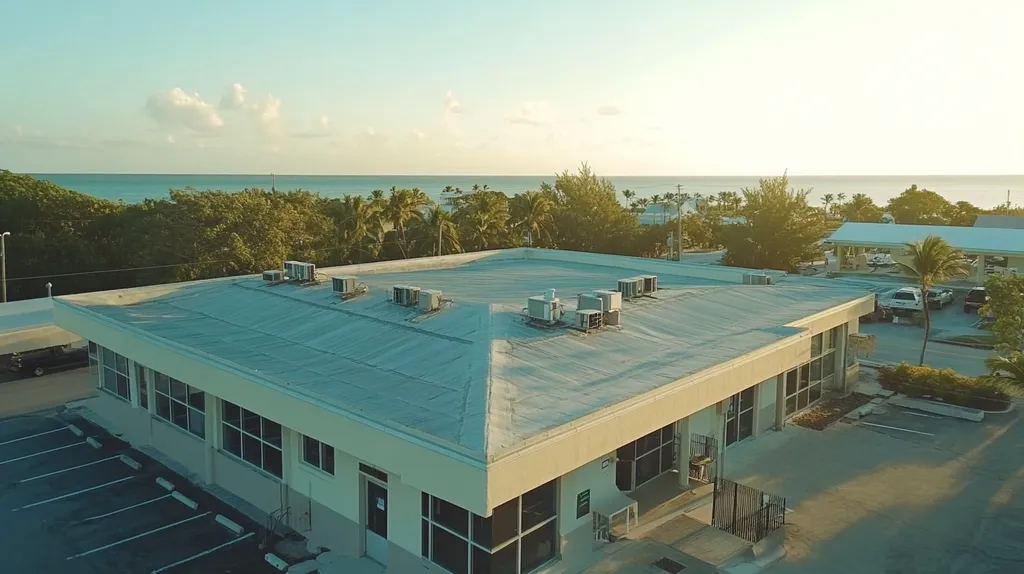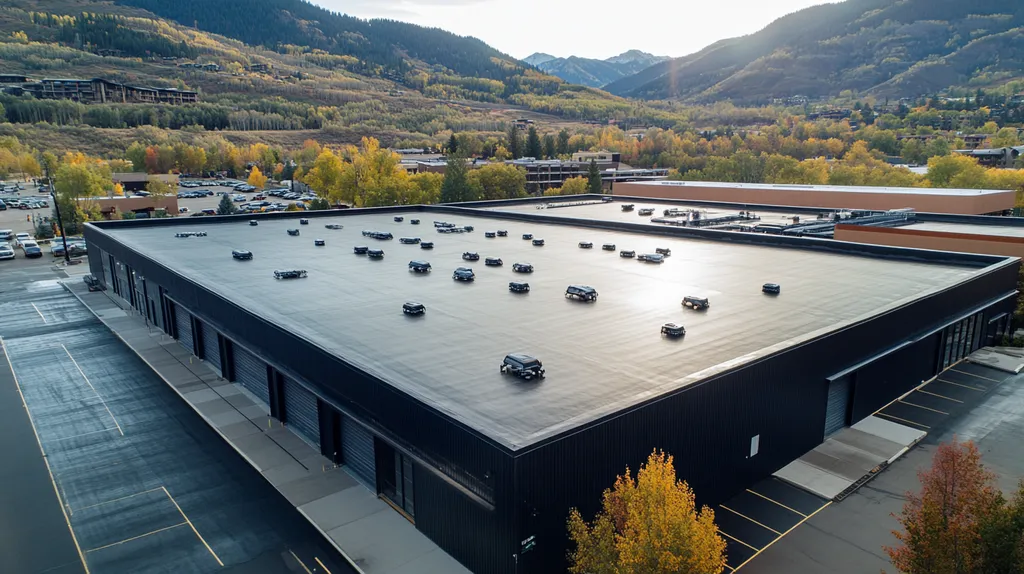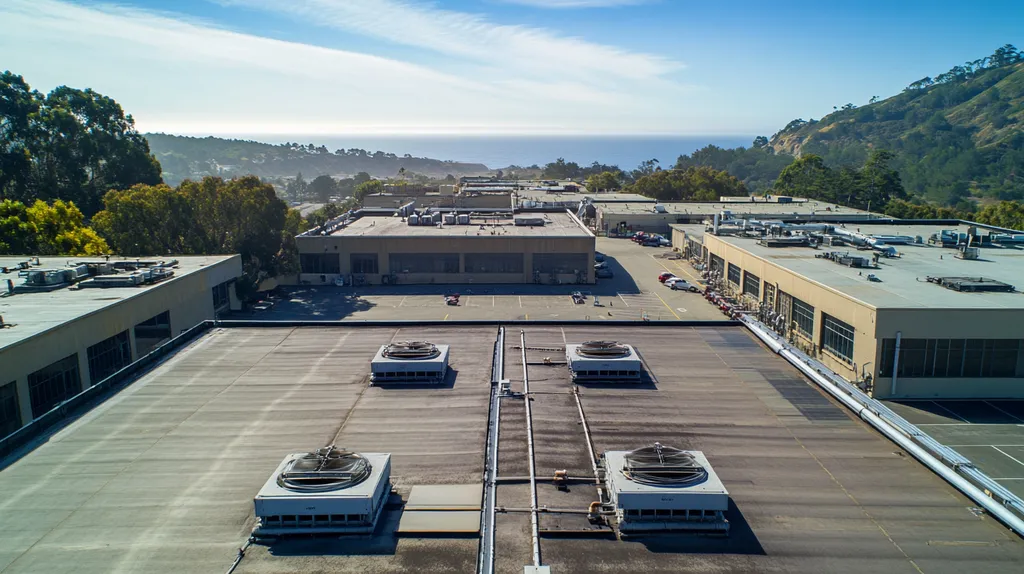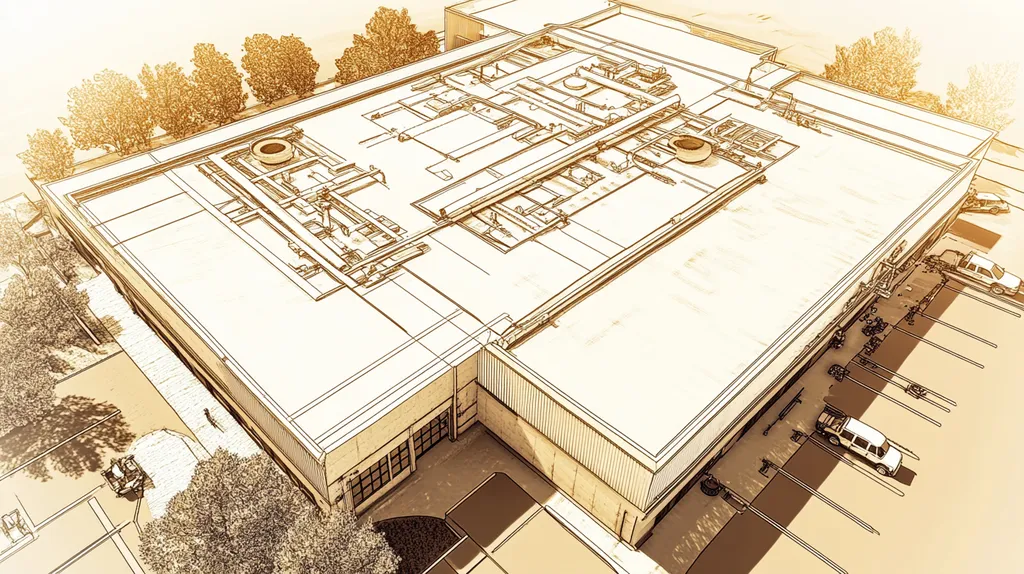Recent industry studies reveal that 90% of premature roof failures stem from inadequate maintenance training and oversight, costing facility managers millions in avoidable repairs annually.
For commercial properties, proper roof maintenance training represents the critical difference between a 15-year and 30-year roof lifespan.
This comprehensive guide provides facility managers with actionable solutions across six essential areas: performance monitoring, financial planning, compliance, risk management, operational procedures, and long-term sustainability strategies.
By implementing these proven protocols, property managers can transform their roofing assets from potential liabilities into reliable, cost-effective building components.
SECTION 1: PERFORMANCE FACTORS
Maintaining the integrity of a flat roof is essential for preventing costly damage and maximizing its lifespan. Industry reports indicate that a staggering 70% of roof leaks stem from inadequate maintenance practices. Neglecting key performance factors can lead to serious structural and financial ramifications for facility managers. This section highlights the vital components that influence roof performance, such as surface condition, drainage efficiency, and overall structural integrity.
Roof Surface Condition Assessment
The condition of a flat roof’s surface plays a crucial role in its durability and effectiveness. Signs of wear, like cracking, blistering, or pooling water, can create weak spots that jeopardize the roof’s integrity. Regular inspections are critical for identifying these concerns before they develop into more significant problems.
Conducting proactive assessments can uncover issues that, if ignored, may result in leaks and costly damages. Facility managers should aim for evaluations at least twice a year, and immediately following severe weather events.
Common indicators of surface degradation include discoloration and debris accumulation. Addressing these symptoms early through routine maintenance can markedly bolster roof integrity.
Key Action Items
Drainage System Efficiency
A well-functioning drainage system is crucial in preventing water accumulation, a leading cause of roof damage. Blocked drains and gutters can result in significant pooling on the roof’s surface, escalating excess weight that compromises the entire structure.
Routine inspections of the drainage system are vital to ensure its functionality. Facility managers should verify that all drains are debris-free and operating as intended.
In regions prone to heavy rainfall, enhancements like additional downspouts may be necessary. These adjustments can effectively manage water flow, significantly reducing pooling risks.
Key Action Items
Structural Integrity Evaluation
The structural integrity of a flat roof is vital for the safety and operational efficiency of any facility. Evaluating this aspect includes both visual inspections and comprehensive structural assessments. Signs of sagging, shifting, or visible damage should immediately raise red flags.
Attention must be given to the underlying framework, including trusses and deck materials, to identify potential weaknesses. A careful examination process helps facility managers preemptively address issues before they escalate.
Implementing structural upgrades, such as reinforcing materials, can significantly extend a roof’s lifespan. Promptly addressing any identified damage is also essential for preserving overall structural health.
Key Action Items
SECTION 2: FINANCIAL CONSIDERATIONS
Ignoring the financial implications of commercial roof maintenance can lead to skyrocketing repair and replacement costs. Alarmingly, research shows that 75% of flat roofs are replaced prematurely due to a lack of proper maintenance. This section will delve into crucial financial considerations, including cost-benefit analyses, budgeting strategies, and the impressive return on investment for preventive maintenance. A solid understanding of these elements empowers facility managers to make smarter, more cost-effective decisions.
Cost-Benefit Analysis of Maintenance
Executing a thorough cost-benefit analysis is vital for effective roof maintenance planning. Implementing a regular maintenance program can drastically lower long-term expenses. For instance, a facility investing $1,000 annually in maintenance can potentially save up to $10,000 in emergency repairs over a decade.
Calculating the costs associated with neglect is equally critical. Without proper upkeep, problems like water damage, mold growth, and structural issues can arise, resulting in high repair expenses and operational disruptions.
Establishing the right maintenance schedule helps to spread costs uniformly. Regular inspections and minor repairs can go a long way in preventing major damage, thus preserving budget integrity and extending the roof’s lifespan.
Key Action Items
Budgeting for Repairs and Replacements
Developing an effective budget for roof repairs and replacements is fundamental to sound facility management. Facility managers should earmark a specific portion of their maintenance budget for roofing needs. It is generally advised to set aside 10-15% of the roof’s value each year to be prepared for unexpected issues.
A detailed budget provides a clear framework for planning and decision-making. It’s important to account for both routine maintenance and unforeseen emergencies to minimize financial pressure during crises.
Familiarity with the roofing lifecycle is essential for successful budgeting. Flat roofs typically have a lifespan of 15-30 years, depending on material quality and maintenance practices. Keeping track of the age and condition of roofs aids in timely replacement decisions.
Key Action Items
ROI on Preventive Maintenance
The return on investment (ROI) from preventive maintenance can be remarkably high yet often goes unnoticed. By investing in preventive measures, facilities can achieve an ROI of 300-400%, highlighting its financial justification. For example, minor preventative repairs costing $500 can avert a $5,000 roof replacement.
When calculating ROI, it is important to consider both measurable and non-measurable benefits. Benefits such as reduced downtime, improved energy efficiency, and higher tenant satisfaction can significantly impact a facility’s financial health.
Moreover, properties with documented maintenance practices often enjoy lower insurance rates, translating into further financial savings. Over time, these cumulative advantages can lead to substantial cost reductions.
Key Action Items
SECTION 3: COMPLIANCE REQUIREMENTS
Ensuring compliance with local building codes and regulations is more than a legal obligation; it is a fundamental responsibility that safeguards the safety and longevity of a commercial roof. Noncompliance can result in severe financial ramifications, including costly repairs and legal liabilities. Facility managers must remain vigilant to stay informed about evolving regulations that impact their roofs. This section covers the essential compliance elements every facility manager must prioritize.
Local Building Codes and Regulations
Local building codes outline specific requirements for commercial roofs, including permitted materials, design features, and maintenance protocols. Since these codes vary widely across municipalities, facility managers must thoroughly understand the regulations applicable to their properties.
Noncompliance can result in high costs, such as enforced repairs or, in extreme cases, mandatory roof replacements. For instance, certain areas require roofs to withstand specific load limits, especially in regions that experience heavy snowfall. A solid grasp of these regulations is vital for maintaining both operational efficiency and budget integrity.
Regular communication with roofing professionals ensures that facility managers remain updated on any changes in building codes. Collaborating with certified contractors also guarantees that new installations or repairs comply with current regulations, enhancing overall safety and reliability.
Key Action Items
Industry Standards for Roof Maintenance
In addition to building codes, adherence to industry standards is vital for effective roof maintenance. Organizations like the National Roofing Contractors Association (NRCA) provide valuable guidelines that govern best practices, enhancing both safety and roof longevity. Following these standards not only improves the roof’s durability but also reduces potential liabilities.
Facility managers should establish routine inspections and maintenance schedules based on recognized industry practices. Regular cleaning and debris removal are essential to prevent water pooling, which can compromise roof integrity over time.
Disregarding these established standards can lead to premature roof failure and costly repairs. Research shows that adhering to proactive maintenance can extend a flat roof’s lifespan by as much as 50%, making compliance not just beneficial but necessary. Furthermore, maintaining awareness of industry standards streamlines warranty claims, as many manufacturers require adherence to their guidelines for coverage.
Incorporating trained professionals into maintenance plans can further ensure compliance with these industry standards, thereby reinforcing the quality and reliability of roof maintenance efforts.
Key Action Items
Insurance and Liability Compliance
Insurance compliance represents a crucial aspect of effective roof management. Many insurance policies require property owners to conduct regular maintenance to uphold coverage. Failing to fulfill these requirements can lead to denied claims following damaging incidents.
Facility managers should proactively ensure that their roofs are regularly inspected and maintained according to insurance guidelines. This diligence protects against liability risks and contributes to an overall risk management framework for the facility.
Keeping meticulous records of all inspections and maintenance activities reinforces compliance. Such documentation can be instrumental if claims arise, demonstrating the diligence exercised in maintaining the roof’s integrity.
Understanding and adhering to insurance requirements enhances building safety and contributes to prudent long-term financial planning, safeguarding both the property and its occupants.
Key Action Items
SECTION 4: RISK MANAGEMENT
Effectively managing a commercial roof involves ongoing risk management to avoid unexpected and costly damages. Studies indicate that leaks contribute to up to 70% of roof failures, resulting not only in structural problems but also significant financial losses. Facility managers must be proactive in identifying potential hazards, mitigating risks, and preparing for unpredictable weather events. This section outlines key strategies to strengthen roof integrity and enhance the long-term performance of facilities.
Identifying Potential Hazards and Damages
Early identification of hazards can prevent serious issues for commercial roofs. Regular inspections are vital for spotting common problems such as punctures, cracks, and standing water. Facility managers should schedule biannual inspections to promptly address any vulnerabilities before they escalate.
Maintaining clear drainage systems is equally important. Clogged drains can cause water accumulation, increasing the risk of leaks and structural damage. Facility managers need to frequently check and uphold the integrity of all drainage pathways to ensure proper water flow.
Understanding the age and material of the roof is crucial. Older roofs are often more vulnerable to damage from adverse weather and require more frequent assessments. Familiarity with the specific weaknesses of a roofing system aids in timely problem identification, reinforcing the necessity of preventive maintenance.
Key Action Items
Mitigating Water Damage and Leaks
Water damage can lead to significant issues, affecting both interiors and underlying structures. Preventing water intrusion should be a top priority for facility managers. This includes proper sealing around roof penetrations and ensuring that flashing is installed correctly.
Leak detection systems offer an additional layer of protection against water damage. These systems alert managers about leaks before they can escalate into major problems. Investing in this technology serves as a safeguard for both assets and operations.
Moreover, keeping water flow paths clear is essential to mitigate risk. Regular checks should ensure that no debris blocks drainage, facilitating effective water disposal from the roof. An unobstructed drainage system reduces the likelihood of leaks and supports a longer roof lifespan.
Key Action Items
Managing Weather-Related Risks
Weather events can be unpredictable and pose severe risks to flat roofs. Facility managers need to implement strategies to manage these risks, particularly in areas prone to extreme conditions. High winds, heavy snowfall, and intense rainfall can all compromise roof integrity.
Understanding local weather patterns and using materials suited for specific conditions is key. For instance, roofs in snowy regions should be designed to handle heavier loads, while proper insulation can help prevent ice dams, a common problem leading to leaks.
Additionally, having an emergency preparedness plan is essential. This plan should outline procedures for inspections before and after severe weather events, allowing managers to respond effectively and minimize potential damage.
Key Action Items
SECTION 5: OPERATIONAL PROCEDURES
Regular operational procedures are crucial for ensuring the integrity of flat roofs. Failure to adhere to these processes can result in severe financial consequences, from unnoticed leaks leading to structural decay to substantial repair costs. By implementing a structured routine, facility managers can maintain functional and durable roofs that protect their investments. This section covers essential procedures for scheduling inspections, cleaning protocols, and managing roof penetrations and flashing.
Scheduling Regular Inspections
Establishing a consistent inspection schedule is vital for proactive roof care. Inspections should be performed at least biannually, ideally in spring and fall, to detect potential issues before weather events exacerbate them.
During these inspections, trained professionals need to evaluate the roof surface, drainage systems, and flashing for any signs of wear or damage. Early detection can decrease repair costs significantly and prolong the roof’s life. Properties that regularly undergo inspections typically see fewer major leaks.
Facility managers should meticulously document all findings and actions taken during these inspections. This valuable record can aid in future assessments and strengthen warranty claims if roofing issues arise. Implementing temperature and moisture sensors can further enhance the inspection process, providing alerts on conditions that suggest possible failures.
Key Action Items
Cleaning and Debris Removal Protocols
Regular roof cleaning is essential for extending a roof’s lifespan. Accumulated debris, such as leaves and dirt, can block drainage systems and create moisture buildup, significantly increasing the risk of leaks.
Establishing a proactive cleaning schedule is recommended, ideally on a monthly basis, to eliminate debris and contaminants. Employing both ground crews and aerial inspections ensures comprehensive cleaning across all roof areas, particularly gutters and downspouts.
The cleaning methods utilized should be gentle and non-abrasive to avoid damaging the roofing surface. This is especially critical for sensitive membranes like TPO and EPDM, as harsh chemicals can create vulnerabilities. Thorough cleaning enhances drainage and contributes to the overall health of the structure.
Key Action Items
Addressing Roof Penetrations and Flashing
Roof penetrations, including vents and HVAC units, require meticulous attention. These areas are particularly vulnerable to leaks if not sealed and maintained correctly.
Regular inspections should concentrate on these spots to ensure that all sealants remain intact and flashing is firmly affixed. Assessments should check for signs of wear such as rust or cracking, with prompt replacements for any compromised flashing to prevent costly leaks.
Facility managers must prioritize training staff to recognize and report potential issues surrounding roof penetrations. Implementing clear communication protocols allows for quicker responses to emerging problems, ultimately enhancing roof performance and integrity.
Key Action Items
SECTION 5: OPERATIONAL PROCEDURES
Regular operational procedures are essential for maintaining the integrity of flat roofs. Neglecting these practices can lead to significant damage and costs, including unnoticed leaks that compromise structural stability. By implementing a structured maintenance approach, facility managers can ensure that roofs remain functional and protective assets. This section outlines critical procedures for scheduling inspections, adhering to cleaning protocols, and managing roof penetrations and flashing.
Scheduling Regular Inspections
Establishing a routine inspection schedule is crucial for proactive roof maintenance. Facility managers should schedule inspections at least twice a year—preferably in the spring and fall—to catch potential problems before adverse weather amplifies them.
During these inspections, trained professionals should assess the roof’s surface, drainage systems, and flashing for any signs of wear or damage. Early detection can greatly reduce repair costs and prolong the roof’s lifespan; properties with regular inspections often report fewer major leaks and lower overall repair expenses.
It’s essential to meticulously document all findings and actions taken during these inspections. This maintenance record not only aids future evaluations but also helps support warranty claims should roofing issues arise. Adding temperature and moisture sensors can further enhance the inspection process, alerting managers to early warning signs of potential failures.
Key Action Items
Cleaning and Debris Removal Protocols
Regular cleaning is vital for extending a roof’s lifespan. Debris accumulation, such as leaves and dirt, can block drainage systems and lead to moisture buildup, increasing the risk of leaks and deterioration.
Establishing a cleaning schedule—ideally, once a month—allows for the timely removal of debris. Utilizing both ground crews and aerial inspections ensures comprehensive cleaning of all roof areas, with special attention to gutters and downspouts.
When cleaning, it’s critical to use gentle, non-abrasive methods to protect the roofing material from damage. This is especially crucial for sensitive membranes, such as TPO and EPDM, where harsh chemicals could increase vulnerabilities. Implementing regular cleaning protocols ensures effective drainage and overall health of the roof and building.
Key Action Items
Addressing Roof Penetrations and Flashing
Roof penetrations, such as vents and HVAC units, require special attention during maintenance. These areas are particularly prone to leaks if not properly sealed and maintained. Regular inspections should focus on these points to ensure all sealants are intact and flashing is securely attached.
Flashing must be inspected for signs of wear, including rust or cracking. Timely replacement of any compromised flashing is essential to prevent water intrusion that can lead to structural damage and safety risks indoors. Facility managers should prioritize these areas during routine checks.
Training staff to recognize and report potential issues surrounding roof penetrations enhances the responsiveness of maintenance efforts. Establishing clear communication protocols can ensure that no problem goes unnoticed, ultimately improving roof performance and longevity.
Key Action Items
The Bottom Line
With 90% of premature roof failures stemming from inadequate maintenance training, facility managers can no longer afford to ignore comprehensive training programs.
The difference between a 15-year and 30-year commercial roof lifespan often comes down to proper maintenance protocols and staff education.
By implementing the systematic approach outlined in this guide—from performance monitoring to risk management—property managers can transform their roofing assets from potential liabilities into reliable, cost-effective building components.
Regular training and adherence to maintenance schedules not only extend roof life but also generate substantial ROI, with studies showing preventive maintenance programs delivering up to 400% returns through avoided repairs and extended service life.
The time to act is now—before the next major weather event tests your roof’s integrity.
FREQUENTLY ASKED QUESTIONS
Q. What are the key performance factors for a commercial roof?
A. Key performance factors for a commercial roof include surface condition, drainage efficiency, and structural integrity. Regular assessments of these elements can prevent issues like leaks and ensure longevity. Implementing routine inspections and maintenance helps to identify and address concerns before they result in costly damage.
Q. How can facility managers budget for an industrial roof?
A. Facility managers should allocate around 10-15% of the roof’s value annually for maintenance. This proactive budgeting allows for both routine and emergency repairs while safeguarding against unexpected costs. Regular condition assessments can aid in making informed decisions about future replacements and necessary upgrades.
Q. Why is compliance important for commercial roofs?
A. Compliance with local building codes is critical to ensuring safety and avoiding legal liabilities. Noncompliance can result in costly fines and required repairs. Facility managers must regularly consult building codes, stay updated with regulations, and document all compliance activities to mitigate risks and enhance roof safety.
Q. How can leaks be managed on a commercial roof?
A. Managing leaks on a commercial roof involves regular inspections and proper sealing of roof penetrations. Implementing a leak detection system can provide early warnings, while maintaining clear drainage pathways prevents water accumulation. Proactively addressing identified issues minimizes the risk of major damage and extends roof life.
Q. What operational procedures should be followed for a flat roof?
A. Key operational procedures include scheduling regular inspections, maintaining cleaning protocols, and closely monitoring roof penetrations and flashing. Establishing a structured maintenance approach ensures early problem detection and prolongs roof functionality, protecting the overall integrity of the property.
Q. How do weather patterns affect commercial roofs?
A. Weather patterns can significantly impact the integrity of a commercial roof. High winds, snow, and heavy rainfall can all create vulnerabilities that lead to leaks and structural damage. Evaluating roofing materials and developing a weather preparedness plan are essential for mitigating these risks and ensuring roof resilience.
Q. What are common signs of damage on an industrial roof?
A. Common signs of damage on an industrial roof include cracking, pooling water, and visible sagging. Regular inspections are vital for identifying these issues early, enabling prompt repairs to prevent further deterioration and costly replacements. Maintaining a detailed maintenance log assists in trend analysis and proactive care.











